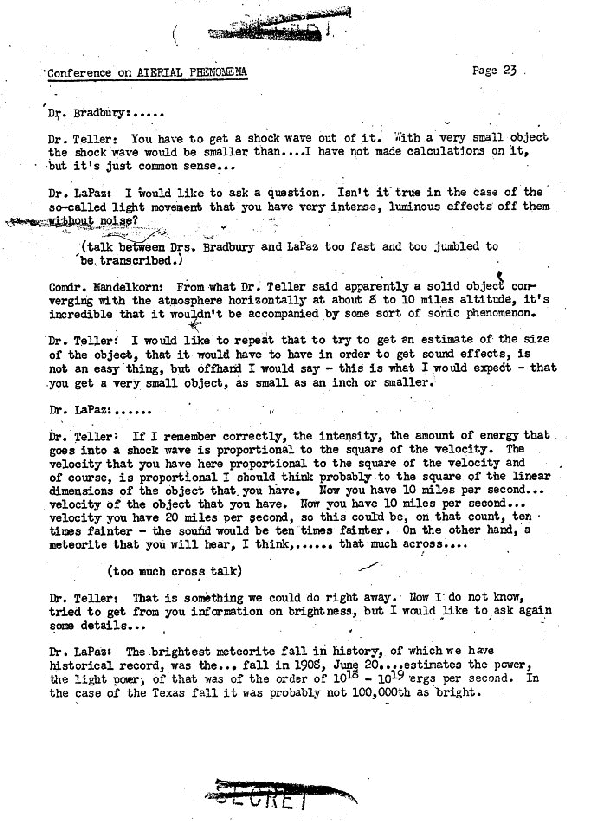This is one of the 24 pages of one of the many formerly secret official documents on this issue. These pages are the minutes of an important conference on the issue held at Los Alamos on February 16, 1949. Representatives of the Army, the FBI, the Air Force and scientists joined together. Dr. La Paz spent two years chasing the green fireballs and explains the issues. Dr. Edward Teller, one of the fathers of the atomic bomb, asks questions.
1 2 3 4 5 6 7 8 9 10 11 12 13 14 15 16 17 18 19 20 21 22 23 24

|
Dr. Bradbury: ...
Dr. Teller: You have to get a shock wave out of it. With a very small object the shock wave would be smaller than ... I have not made calculations on it, but it's just common sense ...
Dr. LaPaz: I would like to ask a question. Isn't it true in the case of the so-called light movement that you have very intense, luminous effects off them without noise?
(talk between Drs. Bradbury and LaPaz too far and too jumbled to be transcribed.)
Commdr. Mandelkorn: From what Dr. Teller say apparently a solid object converging with the atmosphere horizontally at about 8 to 10 miles altitude, it's incredible that it wouldn't be accompanied by some sort of sonic phenomenon.
Dr. Teller: I would like to repeat that to try to get an estimate of the size of the object, that it would have to have in order to get sound effects, is not an easy thing, but offhand I would say - this is what I would expect - that you get a very small object, as small as an inch or smaller.
Dr. LaPaz: ...
Dr. Teller: If I remember correctly, the intensity, the amount of energy that goes into a shock wave is proportional to the square of the velocity. The velocity that you have here proportional to the square of the velocity and of course, is proportional I should think probably to the square of the linear dimensions of the object that you have. Now you have 10 miles per second... velocity you have 20 miles per second, so this could be, on that count, ten times fainter - the sound would be ten times fainter. On the other hand, a meteorite that you will hear, I think, ... that much across ...
(too much cross talk)
Dr. Teller: That is something we could do right away. Now I do not know, tried to get from you information on brightness, but I would like to ask again some details ...
Dr. LaPaz: The brightest meteorite fall in history, of which we have historical record, was the ... fall in 1908, June 20 ... estimates the power, the light power, of that was of the order of 1018 - 1019 ergs per second. In the case of the Texas fall it was probably not 100,000th as bright.
1 2 3 4 4 6 7 8 9 10 11 12 13 14 15 16 17 18 19 20 21 22 23 24